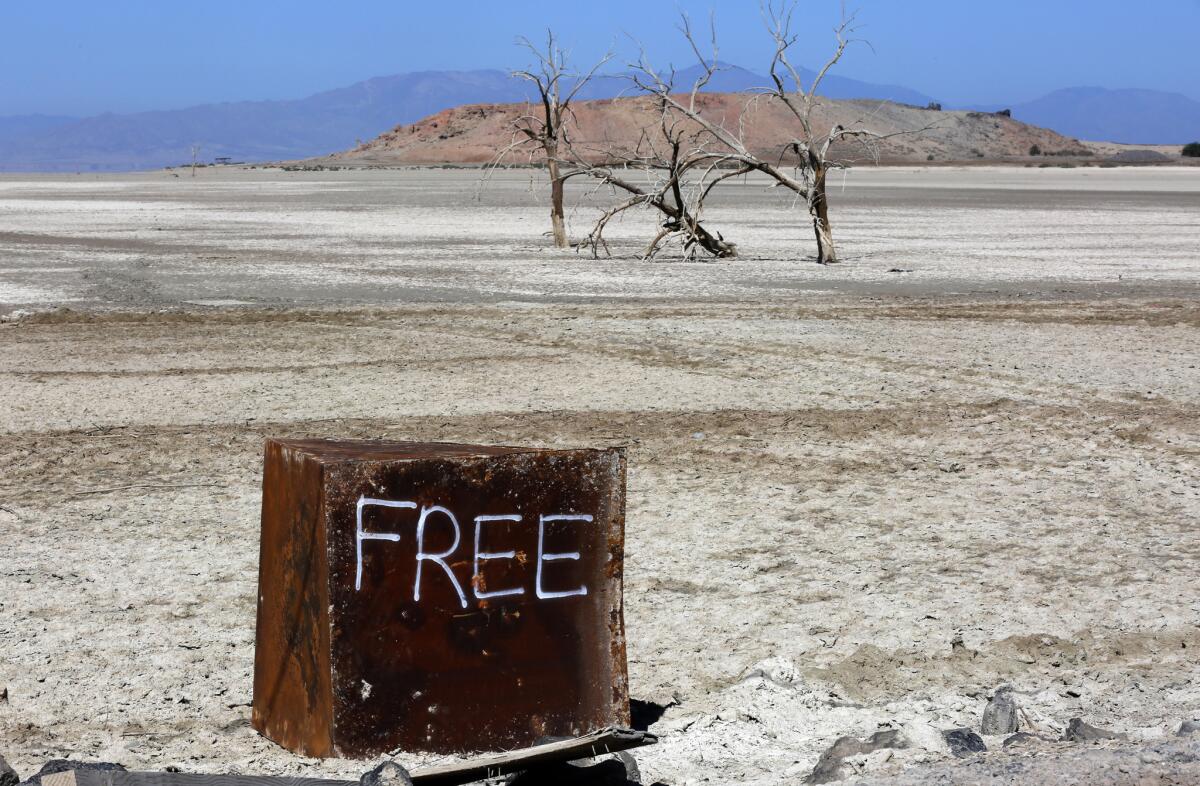As a dying Salton Sea spews harmful dust, Imperial Valley water wars heat up again
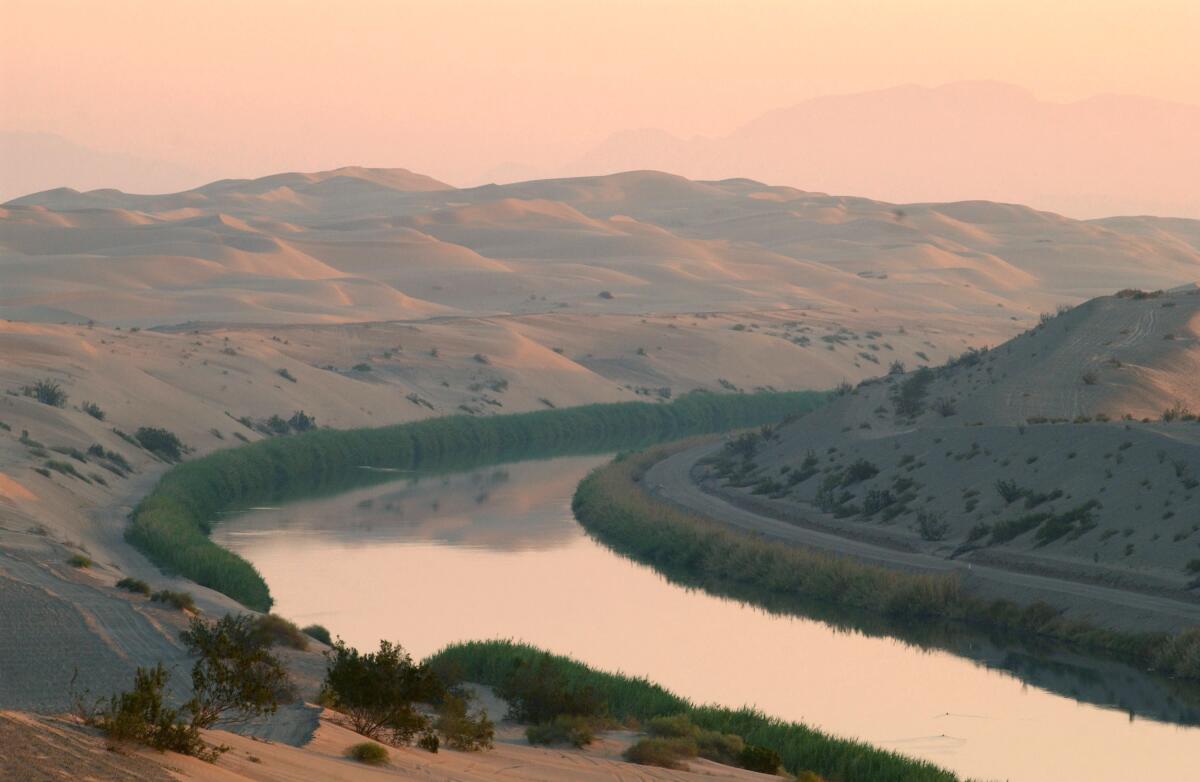
- Share via
The people of California’s Imperial Valley can be as unforgiving as the region’s harsh desert climate.
It’s been 16 years since Bruce Kuhn cast the fateful vote to transfer tens of billions of gallons of Colorado River water from the valley’s sprawling farms to thirsty coastal cities, reshaping water politics in California and across the West.
But for many locals, it might as well have been yesterday.
Voters sent Kuhn packing from the Imperial Irrigation District’s board of directors last month after a primary campaign in which his leading opponent, J.B. Hamby, hammered him over the consequences of the water transfer — including the accelerated demise of the Salton Sea, a giant lake that is spewing lung-damaging dust into the air as it shrinks.
“We cannot afford another four years that look just the same as the last 16,” Hamby said at a January debate.
Kuhn finished third in the primary, missing the November runoff by 44 votes — a razor-thin margin even in an election that saw just 5,000 people cast ballots. Hamby was the top vote-getter and will square off against attorney Ryan Childers.
The results could echo far beyond Imperial County.
Tucked away in California’s southeastern corner, Imperial holds a century-old right to one-fifth of all the water allocated along the Colorado River. The water fuels a $2-billion agriculture industry that produces much of America’s winter vegetables.
Forty million people from Los Angeles to Wyoming depend on the Colorado for drinking water, making the five members of the Imperial Irrigation District board some of the region’s most powerful — if little-known — elected officials.
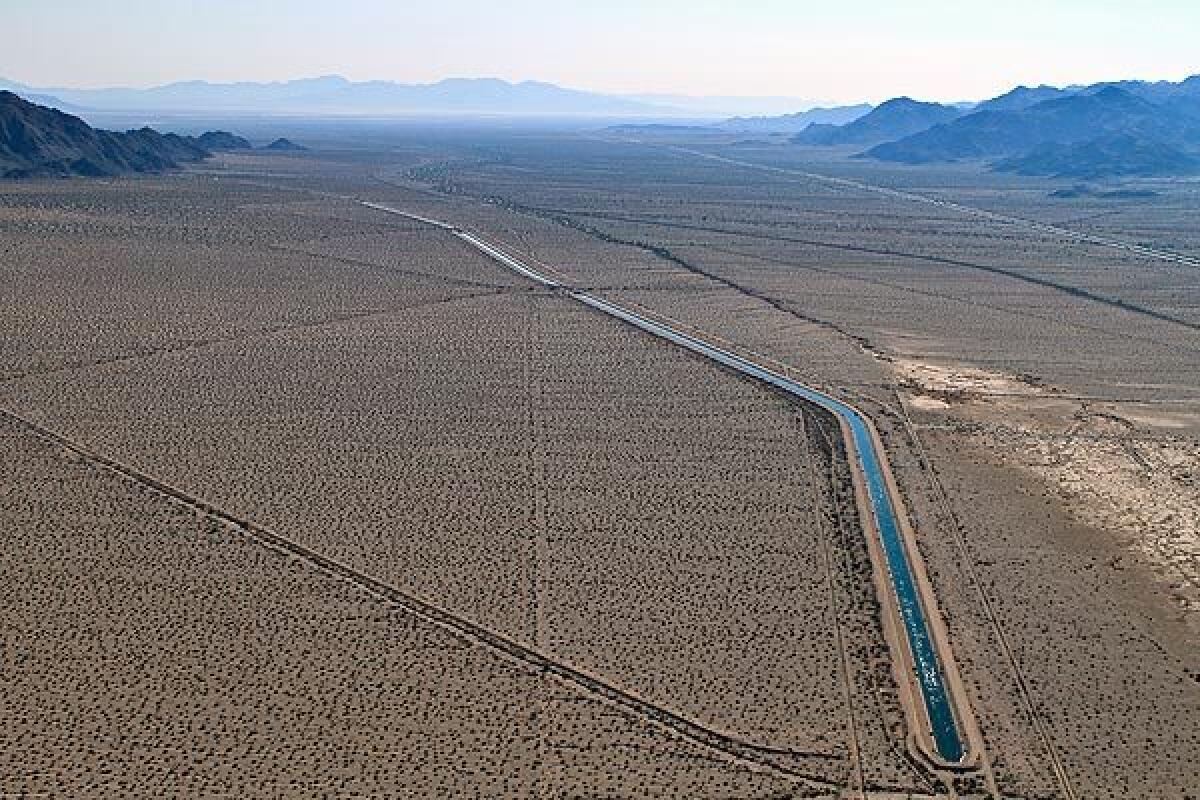
State and federal agencies are gearing up for crucial negotiations over which cities and farming districts will receive less water — and how much less — during future shortages. And shortages are likely. There’s already more Colorado River water allocated across seven states than has historically flowed through the river, and climate change is putting additional strain on its flows.
Solving the Colorado River basin’s long-term problems won’t be possible without the Imperial Valley, said John Fleck, director of the University of New Mexico’s water resources program. Cities and farming districts will need to band together to limit consumption — and that includes the Colorado’s biggest water user, the Imperial Irrigation District.
“We’re not going to have a future where the rich, politically powerful urban areas across the basin are doing without water while we’re still irrigating 3 million acre-feet a year of water in Imperial,” Fleck said. “There has to be some proportionality.”
Even after the water transfer, the Imperial Valley accounts for more than half of California’s overall draw from the Colorado River. In 2018, the valley consumed about as much water from the river as the state of Arizona, and more than any other state.
Imperial’s massive pull on the Colorado stems from a history unlike that of anywhere else in the West.
The valley’s fertile soil is hundreds of miles from the river’s headwaters in the Rocky Mountains. But local farmers were some of the first white settlers to stake a claim to the Colorado, digging canals to irrigate their fields starting in 1901. A few years later, a broken levee flooded the low-lying Salton Sink with the river’s full force, creating California’s largest lake by surface area.
Today about 500 families own most of the Imperial Valley’s irrigated farmland. They form a sort of ruling class in a county where crops are picked mostly by Latino farmworkers, and where poverty levels are higher than almost anywhere else in California.
And they’ve spent the last half-century fighting to maintain control of the Colorado River water they see as their birthright.
In 2018, a group of growers known as Imperial Valley First bankrolled an unsuccessful campaign to unseat two irrigation district directors who insisted on fighting a lawsuit brought by Mike Abatti, a powerful landowner and former director himself, seeking greater control of water supplies for farmers. One of the besieged incumbents, Jim Hanks, held on to his seat by just 41 votes.
Your support helps us deliver the news that matters most. Subscribe to the Los Angeles Times.
Kuhn faced the same kind of wrath from landowning farmers in 2004, when he first lost a reelection bid over his vote to approve the water transfer. He eventually came back into favor with the agriculture community and was elected to the same seat in 2012.
But renewed attacks over the water transfer, and its effects on the Salton Sea, helped sink Kuhn’s bid for a fifth term in 2020.
The lake is largely sustained by farm runoff, so it’s shrinking faster than ever as less water irrigates Imperial Valley fields. As the shoreline recedes, dry lake bed is exposed, polluting the air with windblown dust that may contain pesticides and heavy metals.
The president of the local Border Patrol union, Mike Matzke, endorsed Hamby, writing that Kuhn “decided that your children having chronic nose bleeds, asthma and cancer were worth the 125 million dollars that flows into IID’s Budget annually.”
A few days before the election, signs paid for by the Border Patrol union began appearing around the valley, typically next to “Vote Kuhn” signs. The new signs read: “Got water? No, KUHN sold it.”
The transfer isn’t the only issue that may have hurt Kuhn with voters this time around. But for some locals, his decision from 16 years ago probably looks worse now than ever, because California still hasn’t followed through on its pledge to fix the Salton Sea.
A study published this month, from researchers at the University of New Mexico, estimates that fine particle emissions from Salton Sea lake bed that dried up between 1998 and 2014 probably caused about 100 additional respiratory deaths during those years.
Kuhn and Childers pledged to oppose additional water transfers. But Hamby — a 24-year-old farmer’s son and Stanford University graduate — went further, questioning whether the existing transfers to San Diego County should continue if state officials don’t take stronger action at the Salton Sea. He also proposed that all future transfers be subject to a two-thirds public vote.
“It is time for wealthy metropolitan areas across the Colorado River Basin to adapt to the 21st century and pay for the full cost of their sprawling, unsustainable growth through [desalination], reuse, recycling, conservation and smarter planning,” Hamby wrote in a Facebook before the election. “It is not Imperial Valley’s responsibility to supply their reckless demands.”
That kind of talk worried Kuhn, who said in an interview that Imperial can’t afford to cast itself as an “isolationist” in regional talks.
“If you’re going to be such a stick in the mud that you won’t bend, they’ll snap you. And they’ll snap the IID,” he said.
Kuhn said his decision to approve the water transfer was more complicated than critics make it out to be.
He originally voted “no” on the so-called Quantification Settlement Agreement, leading to the water transfer’s defeat in a 3-2 vote. He switched to “yes” only after the federal government put immense pressure on Imperial by trying to revoke a big chunk of its water supply unilaterally — and even then, only after state lawmakers passed a bill promising to restore the Salton Sea.
Kuhn said payments from San Diego County Water Authority, the main beneficiary of the transfer, have funded water efficiency measures at farms that have allowed Imperial to reduce consumption while keeping nearly all its irrigated acreage in production.
“Did I want to do it? No. But has it been working? It’s been working since that kid was 5 years old,” Kuhn said, referring to Hamby.
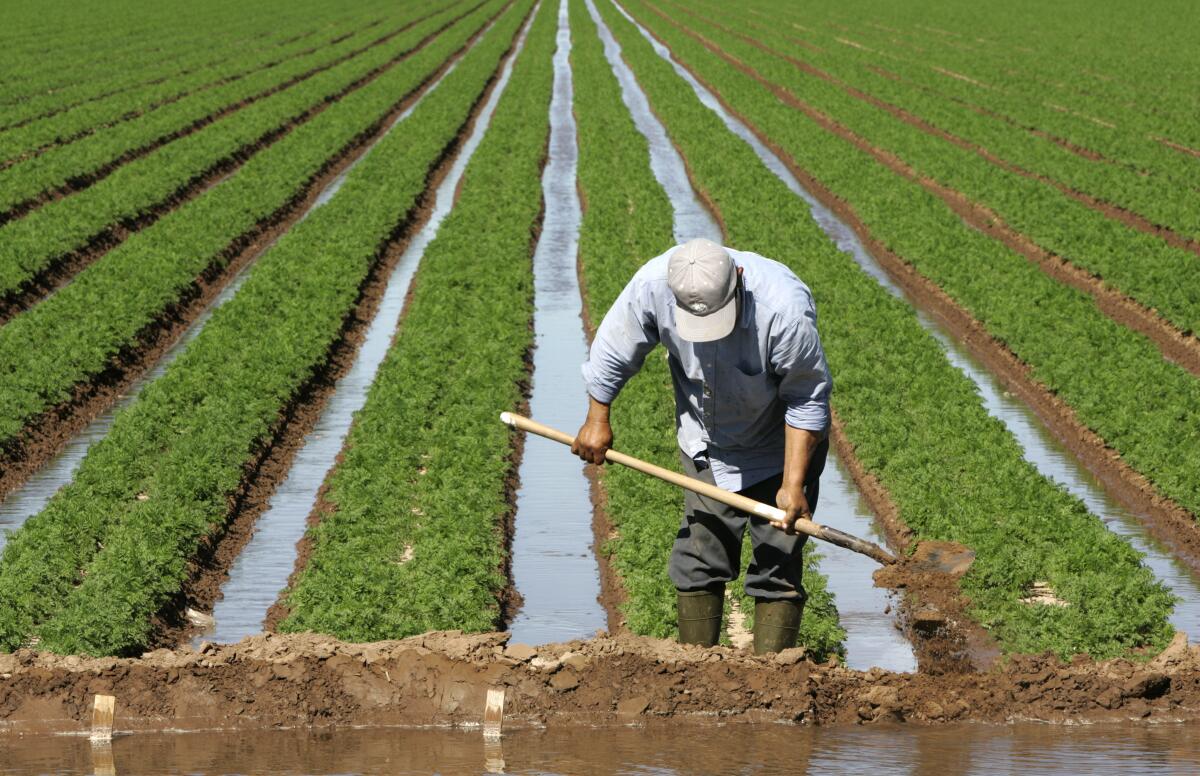
The campaign was also marked by speculation over which candidates might secretly be backed by which local power brokers — a common pastime in Imperial, whose insular politics are defined by family ties, small-town allegiances and deeply held mistrust.
Some locals pointed to ties between Hamby and associates of Abatti, whose lawsuit against the irrigation district is continuing.
Abatti’s sister-in-law Deborah Owen, the county’s assistant district attorney, was Hamby’s high school mock trial coach. He once described her as “a bit of a mentor to me.” Hamby also received a $10,000 college scholarship from — and briefly interned for — ZGlobal Inc., an engineering firm that developed a close relationship with Abatti through several energy and water projects.
J.P. Menvielle — a former irrigation district board member who lost his seat in 2012 after Imperial Valley First spent heavily to defeat him — worries that Hamby’s candidacy is another effort by dissatisfied landowners to assert control over the public agency.
“They’re trying to get three votes on the IID board to get control of the water,” Menvielle said.
Hamby countered that he and Childers both received contributions from farmers who had previously given money to Imperial Valley First, suggesting there was no unified front from agriculture in this election. Hamby also said he has faced criticism from farmers unhappy with his insistence that neither landowners nor the irrigation district truly own the valley’s water supply.
He described Owen and her husband, Jimmy Abatti, as family friends, but said they didn’t provide any support to his campaign.
“In the Imperial Valley, everybody pretty much knows everybody,” Hamby said in an interview.
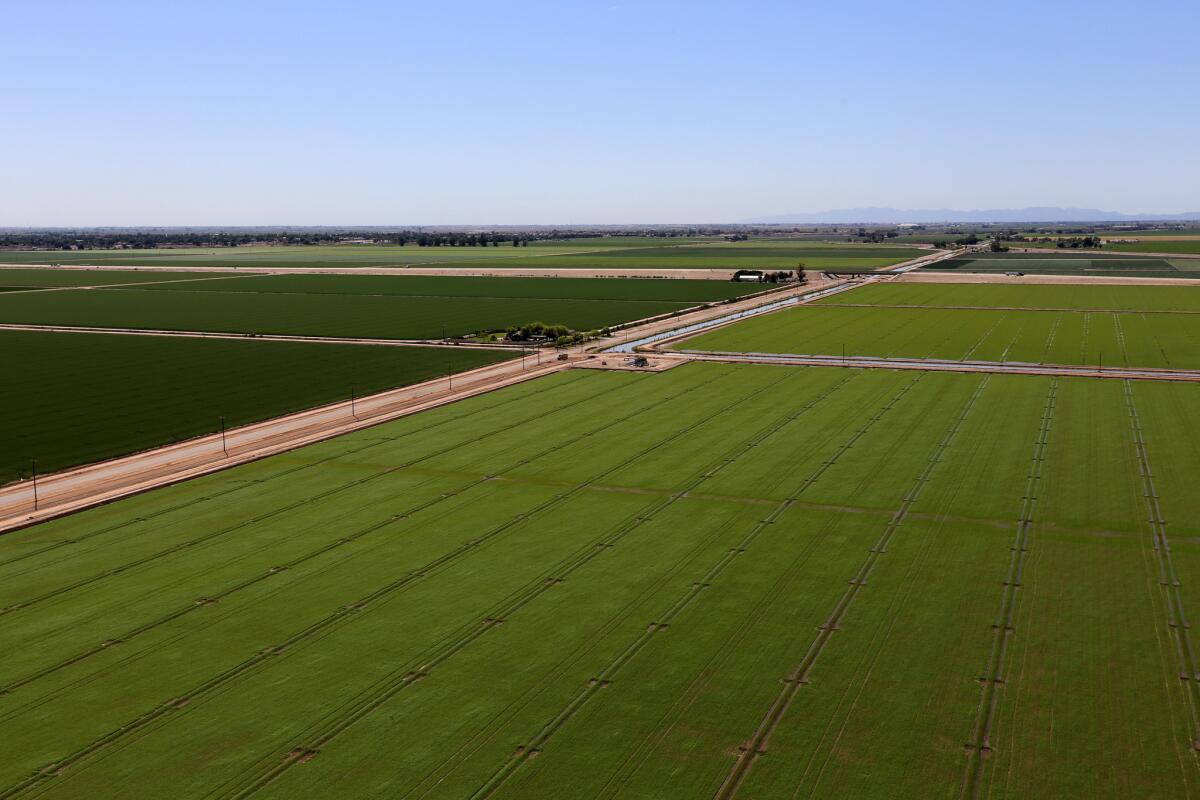
Asked about upcoming Colorado River negotiations, Hamby struck a more conciliatory note than he did during the campaign. He said Imperial should work closely with other farm districts, rural areas and Native American tribes across the West to to make sure their collective interests aren’t steamrolled by cities. And he acknowledged Imperial has a role to play in staving off shortages.
“What we need to do is not be insular and cut off from the rest of the world and only come out to blow things up,” Hamby said.
Childers said one of his top priorities in regional talks would be establishing Imperial’s right to store Colorado River water in Lake Mead outside Las Vegas. The valley would get a bank account to tap during dry years, and other farm districts and cities would benefit because the stored water could help keep Mead from dropping to levels that would trigger cutbacks across the Southwest.
“We have to strike a balance that addresses our interests in terms of keeping our water here in the valley, but also shows that we’re willing to be a player in addressing issues on the river,” Childers said. “That may be a very difficult balance to strike.”
In the Imperial Valley, one thing is certain. If the winning candidate doesn’t strike the right balance, voters won’t forget.
